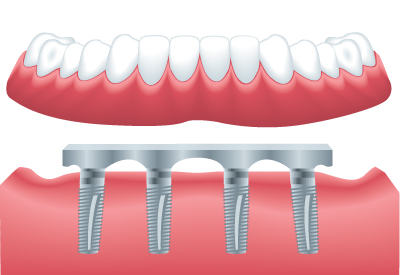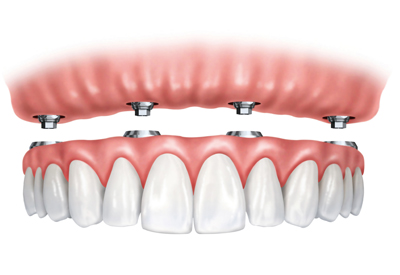Intro to Dental Implants Dental Implants 101 Dental Implants vs Dentures Single Missing Tooth
Multiple Missing Teeth Implant Supported Dentures Are Dental Implants right for me? FAQs
Regular dentures rest on top of your gums, causing bone deterioration and leaving space that can cause complications such as loose fit, slipping, or clicking sounds. Implant supported dentures are anchored in the mouth through attachment to dental implants. This type of dentures is most often used in the lower jaw where removable dentures are less stable, but can also be used in the upper jaw also.
Implant supported dentures are snapped into place on top of dental implants. This provides a secure fit and hold, eliminating looseness or slipping without the need for paste or adhesives. Implant supported dentures are designed so that they can be removed for regular cleaning, or you can opt for fixed implant supported dentures, which function as permanent teeth.
Bar-Retained Dentures
 When fitting bar-retained dentures, three or more dental implants are placed into the jaw bone. Metal bars then run along the gum line between each of the implants. The denture rests on the bars, attaching with metal clips. This structure secures the denture’s placement without the need for the steel studs used in ball-retained dentures. Many patients have opted for this alternative as it eliminates the rubbing, loosening, and discomfort associated with traditional removable dentures.
When fitting bar-retained dentures, three or more dental implants are placed into the jaw bone. Metal bars then run along the gum line between each of the implants. The denture rests on the bars, attaching with metal clips. This structure secures the denture’s placement without the need for the steel studs used in ball-retained dentures. Many patients have opted for this alternative as it eliminates the rubbing, loosening, and discomfort associated with traditional removable dentures.
Ball-Retained Dentures
 Ball-retained dentures, also called stud-attached dentures, function with a ball and socket mechanism. The denture base has several sockets that line up with balls placed on dental implants in the jaw bone. The balls and sockets fit together for an extremely secure fit, allowing for an open palate denture. Ball and socket attachment is even less likely to slip or move, restoring the patient’s ability to eat and speak regularly.
Ball-retained dentures, also called stud-attached dentures, function with a ball and socket mechanism. The denture base has several sockets that line up with balls placed on dental implants in the jaw bone. The balls and sockets fit together for an extremely secure fit, allowing for an open palate denture. Ball and socket attachment is even less likely to slip or move, restoring the patient’s ability to eat and speak regularly.
Next >>